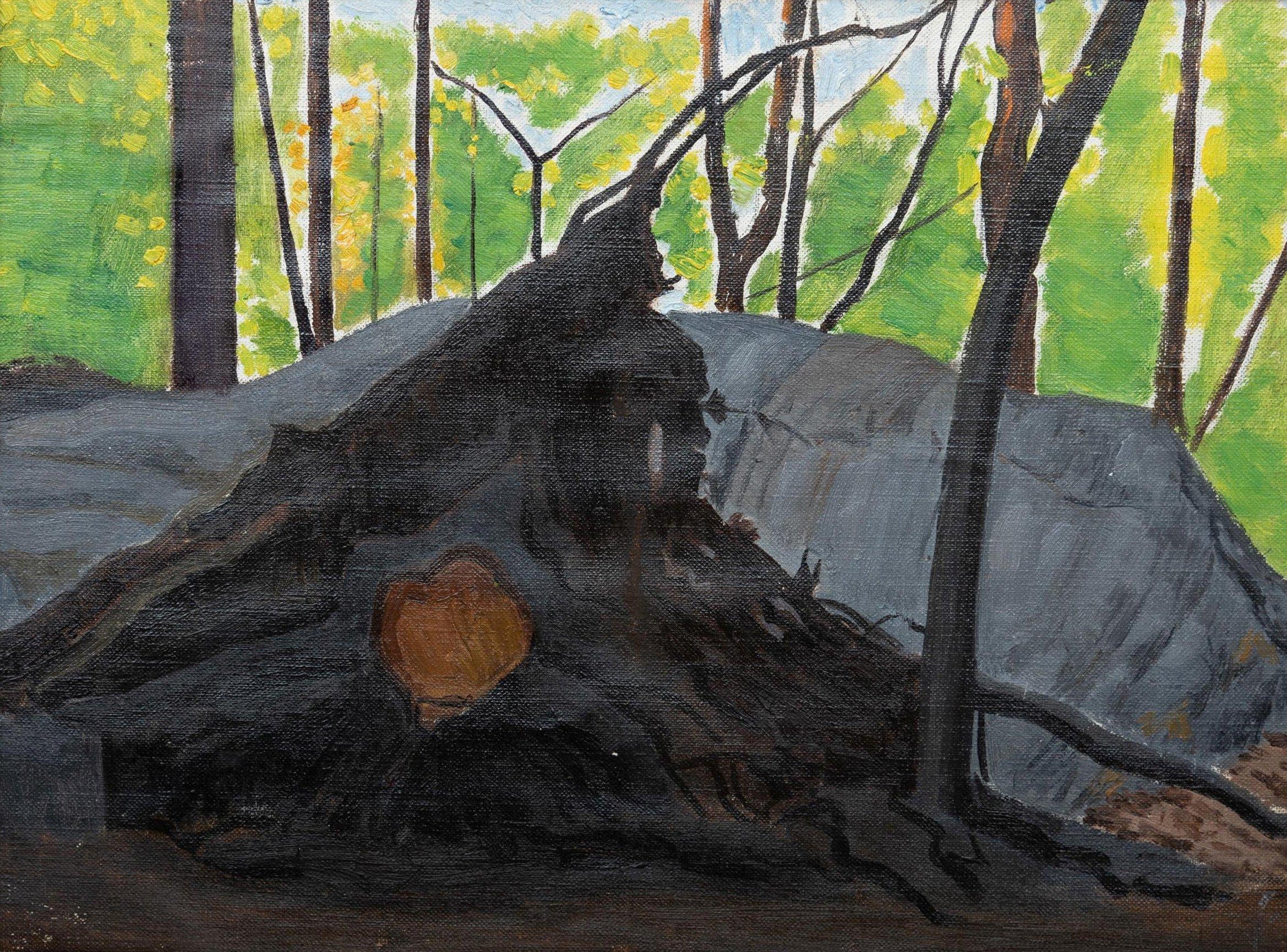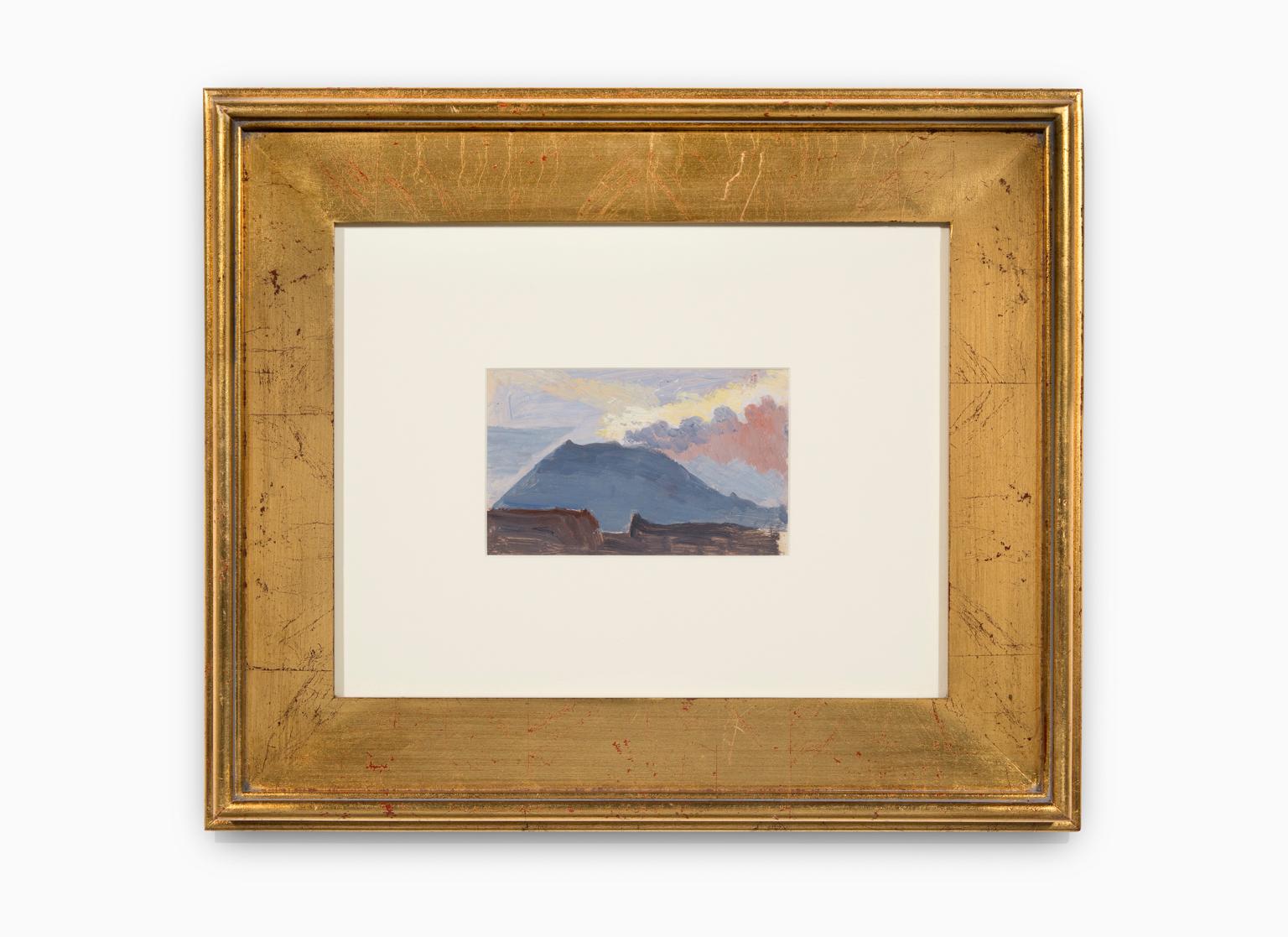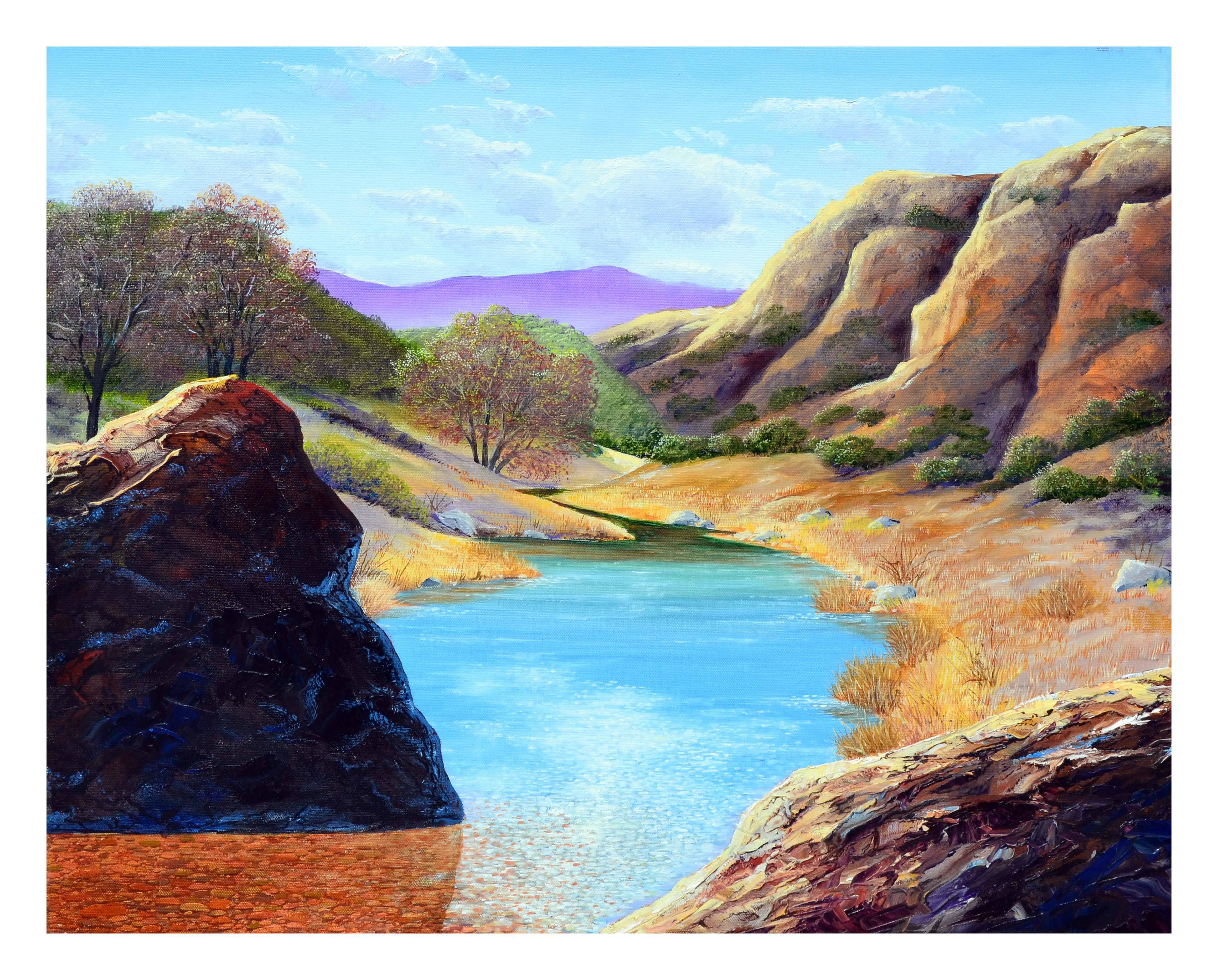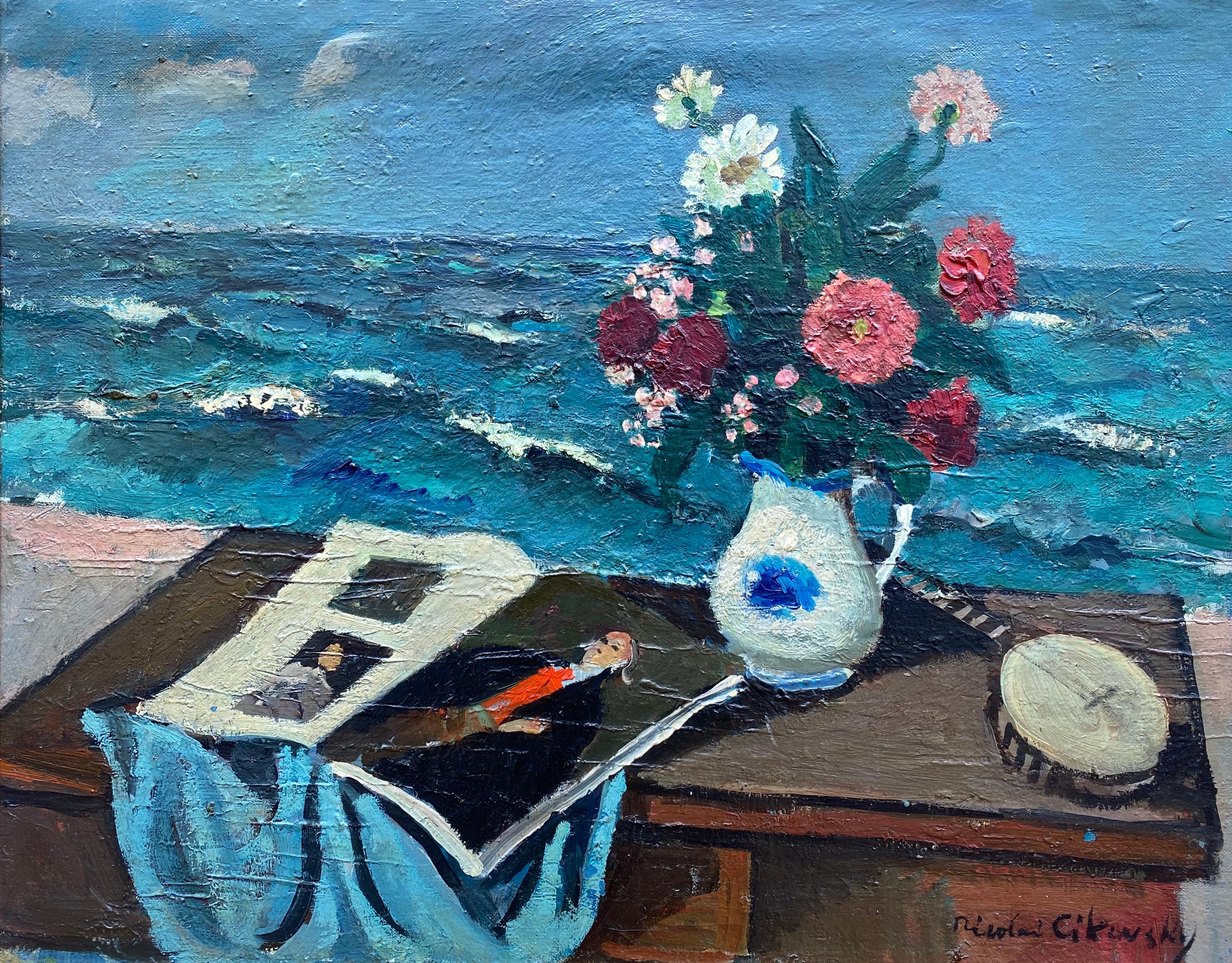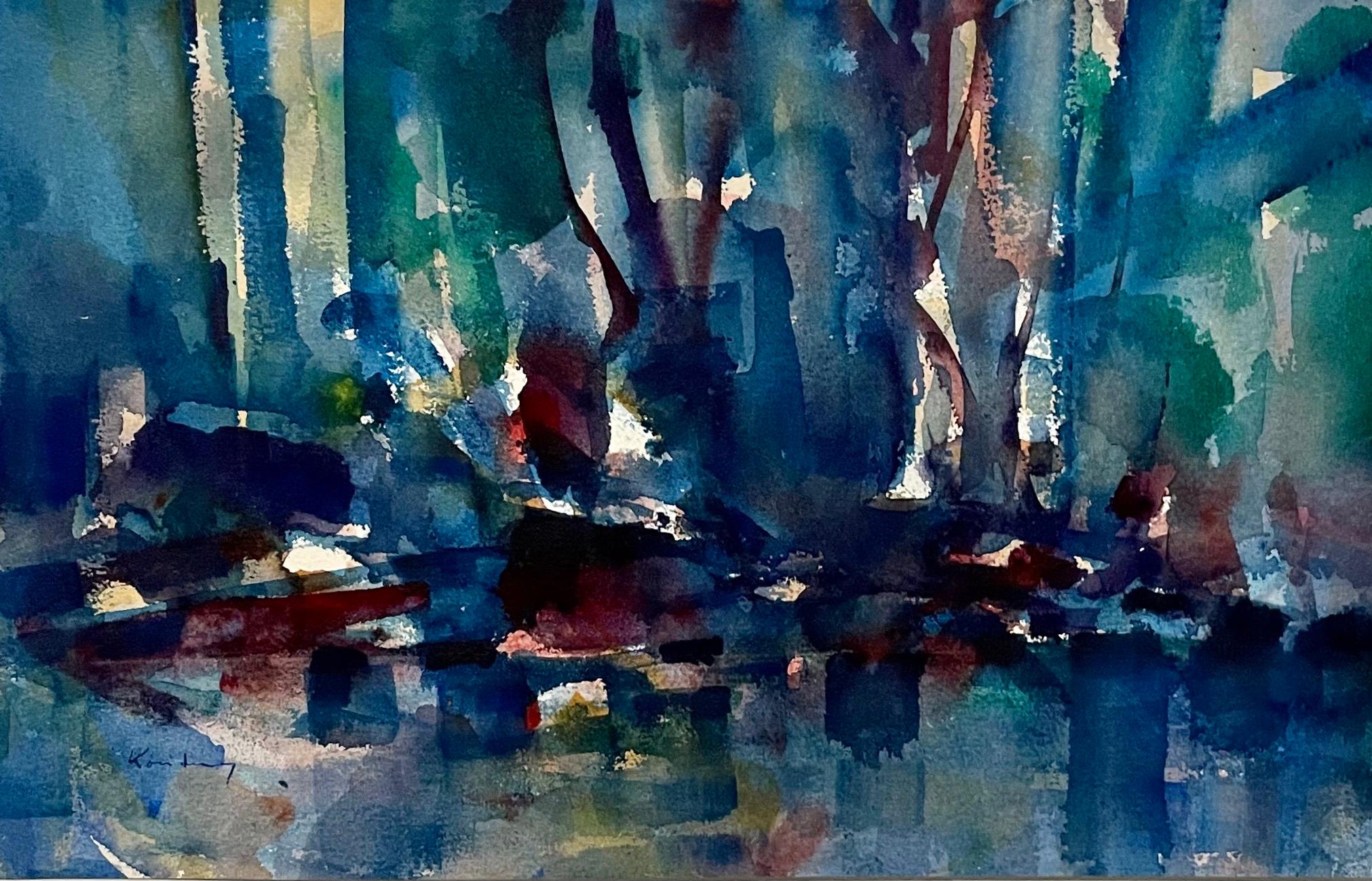Items Similar to Large Modernist Oil Painting Bridge over the Water Landscape
Want more images or videos?
Request additional images or videos from the seller
1 of 8
Saul ScharyLarge Modernist Oil Painting Bridge over the Water Landscape
About the Item
Saul Schary was born in 1904 in Newark, New Jersey. Painter, Printmaker, Illustrator. He lived and worked in New York City and New Milford, Connecticut. Schary studied at the Art Students League, New York; the Pennsylvania Academy of Fine Arts, and abroad in Paris.
He was a member of the Artists Equity Association, New York City; the Pennsylvania Academy of Fine Arts (Fellow); the College Art Association of America, New York City; and the Royal Society of Artists, London.
His work has been exhibited at several museums including the Whitney Museum of American Art NY. Schary has also exhibited with the Pennsylvania Academy of Fine Arts Annual (1933-51), Art Institute of Chicago, California Palace of the Legion of Honor and Allied Artists of American Gallery (Los Angeles, CA). This fine example is signed Schary. Well Listed: Askart, Who Was Who In American Art, Davenport's Art Reference and Price Guide, Mallett. lifelong friend of Arshile Gorky.
Schary partook in the First American Artists' Congress Against War and Fascism in 1935, which produced a petition signed by more than 300 artists including co-founders Stuart Davis, Adolph Dehn, William Gropper, Hugo Gellert, Saul Schary, and Moses Soyer as well as many fellow artists. (Milton Avery, Ben Shahn, Raphael Soyer, Max Weber, amongst others)
Perls Galleries
Associated American Artists Galleries
Harry Salpeter Gallery
St. Louis Art Museum Richardson Memorial Library
Gallery of Mrs. Cornelius J. Sullivan
Joseph Luyber Galleries
- Creator:Saul Schary (1904 - 1978, American)
- Dimensions:Height: 23 in (58.42 cm)Width: 31 in (78.74 cm)
- Medium:
- Movement & Style:
- Period:
- Condition:minor wear, minor wear to frame.
- Gallery Location:Surfside, FL
- Reference Number:1stDibs: LU38212562232
About the Seller
4.9
Platinum Seller
These expertly vetted sellers are 1stDibs' most experienced sellers and are rated highest by our customers.
Established in 1995
1stDibs seller since 2014
1,565 sales on 1stDibs
Typical response time: 1 hour
- ShippingRetrieving quote...Ships From: Surfside, FL
- Return PolicyA return for this item may be initiated within 3 days of delivery.
More From This SellerView All
- Modernist Abstract Expressionist Watercolor Painting Bauhaus Weimar Pawel KontnyBy Pawel KontnyLocated in Surfside, FLAbstract watercolor composition bearing the influence of the earlier color-block compositions of Paul Klee. Pawel August Kontny, (Polish-German-American artist) He was born in Laurahuette, Poland, in 1923, the son of a wealthy pastry shop owner. In 1939 he began studying architecture in Breslau where he was introduced to the European masters and to the work of some of the German Expressionists, soon afterward banned as "degenerate artists" and removed from museums throughout Germany by the Nazi regime. His studies were interrupted by World War II. Drafted into the German army, traveling in many countries as a soldier, he sketched various landscapes but in 1945, he was captured and held as a prisoner of war in Italy. After the war, he studied at the Union of Nuremberg Architects to help design buildings to replace ones destroyed in the war. He recorded his impressions of the local population and the landscapes through his watercolors and drawings. Pawel Kontny thereafter moved to Nuremberg, Germany, becoming a member of the Union of Nuremberg Architects and helping to rebuild the city's historic center. He soon decided to concentrate on his professional art career. He married Irmgard Laurer, a dancer with the Nuremberg Opera. Pavel Kontny 's career as an artist was launched with his participation in an all German exhibition, held at the Dusseldorf Museum in 1952. He held one-man shows in Germany, Switzerland and the United States. During his trip to the United States in 1960, Kontny became instantly enamored with Colorado, and decided to relocate to Cherry Hills with his wife and two children. He quickly established himself in the local art community, being affiliated for a time with Denver Art Galleries and Saks Galleries. His subject matter became the Southwest. During this time he received the Prestigious Gold Medal of the Art Academy of Rome. His extensive travel provided material for the paintings he did using his hallmark marble dust technique. he also worked equally in pastel, watercolor, charcoal and pencil-and-ink. in a style which merged abstraction and realist styles, influenced by Abstract Expressionist painting and South Western American landscapes. In the early 1960s he was one of only a few European-born professional artists in the state, a select group that included Herbert Bayer (1900-1985), a member of the prewar Bauhaus in Weimar and Dessau, Germany, and Roland Detre (1903-2001), a Hungarian modernist painter. As a Denver, Colorado resident, Pavel Kontny exhibited at galleries and museums throughout the United States, Germany and Japan. There, he was inspired by frequent trips to Native American pueblos in the Southwest, as well as by the study of the Plains Indians of Montana and Wyoming. Over the years Kontny had a number of students and generously helped young artist by hosting exhibitions at his Cherry Hills home. For many years he generously donated his paintings to support charitable causes in Denver. Influences during his European years included German pastelist C.O. Muller, German Informel painter Karl Dahmen and Swiss artist, Hans Erni. In the early 1950s his painting style showed the influence of the Die Brücke (The Bridge), a group of German expressionist artists formed in Dresden in 1905 who had a major impact on the evolution of modern art in the twentieth century in Germany. By the middle of the decade his style incorporated more referential abstraction and total abstraction, resulting in part from his study of Hans Hartung, a German artist based in Paris who exhibited his gestural abstract work in Germany. The American moon landing in 1969 inspired Paul Kontny...Category
20th Century American Modern Landscape Paintings
MaterialsCanvas, Oil
- Modernist Colorado Oil Painting Abstract Cityscape Harbor Scene Pawel KontnyBy Pawel KontnyLocated in Surfside, FLUrban landscape of city harbor, marine scene, (North Africa?) bearing the influence of the earlier color-block compositions of Paul Klee. Modernist Cityscape 24" x 36" sight. oil on ...Category
20th Century American Modern Landscape Paintings
MaterialsCanvas, Oil
- 1927 Oil Painting Eiffel Tower Paris American Modernist Wpa Artist Morris KantorBy Morris KantorLocated in Surfside, FLMorris Kantor New York (1896 - 1974) Paris from the Ile St. Louis, 1927 (view of Eiffel Tower) Oil painting on canvas Hand Signed lower left. Provenance: Hirshhorn Museum and Sculpture Garden, Smithsonian Institution ( bears label verso) Size: 20 3/4"H x 28 1/8"W (sight), 28.75 "H x 36"W (framed) Morris Kantor (Belarusian: Морыс Кантор) (1896-1974) was a Russian Empire-born American painter based in the New York City area. Born in Minsk on April 15, 1896, Kantor was brought to the United States in 1906 at age 10, in order to join his father who had previously relocated to the states. He made his home in West Nyack, New York for much of his life, and died there in 1974. He produced a prolific and diverse body of work, much of it in the form of paintings, which is distinguished by its stylistic variety over his long career. Perhaps his most widely recognized work is the iconic painting "Baseball At Night", which depicts an early night baseball game played under artificial electric light. Although he is best known for his paintings executed in a realistic manner, over the course of his life he also spent time working in styles such as Cubism and Futurism, and produced a number of abstract or non-figural works. A famous cubist, Futurist, painting of his "Orchestra" brought over 500,000$ at Christie's auction house in 2018 Kantor found employment in the Garment District upon his arrival in New York City, and was not able to begin formal art studies until 1916, when he began courses at the now-defunct Independent School of Art. He studied landscape painting with Homer Boss (1882-1956). In 1928, after returning to New York City from a year in Paris, Kantor developed a style in which he combined Realism with Fantasy, often taking the streets of New York as his subject matter. He did some moody Surrealist Nude paintings and fantasy scenes. In the 1940's he turned towards figural studies. Later in his career, Kantor himself was an instructor at the Cooper Union and also at the Art Students League of New York in the 1940s, and taught many pupils who later became famous artists in their own right, such as Knox Martin, Robert Rauschenberg, Sigmund Abeles and Susan Weil...Category
1920s American Modern Landscape Paintings
MaterialsCanvas, Oil
- 1930 Oil Painting Sea Side Sailboats American Modernist WPA Artist Morris KantorBy Morris KantorLocated in Surfside, FLMorris Kantor, American, 1896-1974 Seaside View, 1930 Hand signed M. Kantor and dated 1930 lower right Oil on canvas 22 1/4 x 19 1/4 inches 24 1/2 x 21 (frame) Morris Kantor (Belarusian: Морыс Кантор) (1896-1974) was a Russian Empire-born American painter based in the New York City area. This is a beautiful boat scene with a river or lake probably on Long Island. Born in Minsk on April 15, 1896, Kantor was brought to the United States in 1906 at age 10, in order to join his father who had previously relocated to the states. He made his home in West Nyack, New York for much of his life, and died there in 1974. He produced a prolific and diverse body of work, much of it in the form of paintings, which is distinguished by its stylistic variety over his long career. Perhaps his most widely recognized work is the iconic painting "Baseball At Night", which depicts an early night baseball game played under artificial electric light. Although he is best known for his paintings executed in a realistic manner, over the course of his life he also spent time working in styles such as Cubism and Futurism, (influenced by the Art Deco movement) and produced a number of abstract or non-figural works. A famous cubist, Futurist, painting of his "Orchestra" brought over 500,000$ at Christie's auction house in 2018. Kantor found employment in the Garment District upon his arrival in New York City, and was not able to begin formal art studies until 1916, when he began courses at the now-defunct Independent School of Art. He studied landscape painting with Homer Boss (1882-1956). In 1928, after returning to New York City from a year in Paris, Kantor developed a style in which he combined Realism with Fantasy, often taking the streets of New York as his subject matter. He did some moody Surrealist Nude paintings and fantasy scenes. In the 1940's he turned towards figural studies. Later in his career, Kantor himself was an instructor at the Cooper Union and also at the Art Students League of New York in the 1940s, and taught many pupils who later became famous artists in their own right, such as Knox Martin, Robert Rauschenberg, Sigmund Abeles and Susan Weil...Category
1930s American Modern Landscape Paintings
MaterialsCanvas, Oil
- Modernist Impasto Painting Mountain with Ocean Landscape J. James AkstonLocated in Surfside, FLJ. James Akston Mountain Landscape by ocean Acrylic on Board Frame: 11.5 x 16. Image: 5 X 9.5 Joseph James Akston was a Polish American sculptor, painter, known for surrealist abstract painting and Aubusson (for Les Ateliers Pinton Frères, tapisserie, Aubusson) tapestry artist. Born in Warsaw, Poland in 1898 he died in Palm Beach Florida in 1983. During the 1960s and '70s the entrepreneur-artist James Joseph Akston adopted a unique Surreal Expressionist style in order to present his private primordial universe and lampoon its denizens, a ribald cast of animal creatures with human foibles. A successful industrialist, he began his career with General Motors foreign operations and then started his own business. Intermittently he studied painting, first with Jerry Farnsworth in North Truro (Mass.) and then with Jose Clemente Orozco in Mexico. In the early 1960s Akston became publisher-editor of a group of art publications which included The Magazine Arts. Initially an abstract expressionist, Akston had one-man exhibitions at the New York Convention Center and the Corcoran Museum in Washington. Since 2015 the record price for this artist at auction is $12,575 USD for Spheres Aux Triangles Aubusson Tapestry, sold at Bonhams New York in 2019. He was a Graduate of Georgetown University. He sat on the board of the Norton Museum. Exhibitions 1976 Hokin Gallery 1966 Gallery 63 NYC 1960 Gallery 63 Rome , Italy Select Public Collections National Museum, Wshington DC Boca Museum of Art Whitney Museum of Art, NYC Museum of Modern Art, NYC Museum of African Art Washington DC (Now part of Smithsonian Museum) Bibliography: 1962 Art...Category
Mid-20th Century American Modern Landscape Paintings
MaterialsOil
- 1972 Gestural Oil Painting Boat in Harbor Figural Abstraction Raoul MiddlemanBy Raoul MiddlemanLocated in Surfside, FLRaoul Middleman (born 1935 in Baltimore, Maryland) is an American painter. Middleman has been a member of the Maryland Institute College of Art faculty since 1961. American University Museum at the Katzen Center has described Middleman as a "Baltimore maestro [whose] nudes are not pretty—they are sagging, dimpled, and real. His cityscapes reveal the underbelly of post-industrial rot, his narrative paintings give contemporary life to his personal obsessions. They are intelligent, messy, and utterly masterful." From an interview with RM "I was doing abstract art. Then Roy Lichtenstein came around, and I wanted to be current. I remember Grace Hartigan said, “You’ve gotta go to New York, seize destiny by the hand.” My friend Jon Schueler took my slides up to Eleanor Ward, who had the Stable Gallery. My Pop art paintings were discovered. I moved to New York into Malcolm Morley’s old loft down on South Street. Agnes Martin was upstairs... People who interest me come from different quarters. I knew guys around Schueler, like B.H. Friedman. But I also knew the Pop world pretty well – Al Hansen, Richard Artschwager, Lichtenstein. I became friends with Raoul Hague and I rented a place in Port Jervis, New York. I started doing my first landscapes up there. I thought making landscapes was the dumbest thing you could do. You got flies, insects, cow pies, humidity. But I loved it... I went down to the meetings of the Figurative Alliance. I met my friends there — Paul Resika, Paul Georges, Rosemarie Beck...Category
1970s American Modern Landscape Paintings
MaterialsOil, Board
You May Also Like
- "Tree, Trunk, and Roots, New York" Joseph Stella, American ModernismBy Joseph StellaLocated in New York, NYJoseph Stella (1877 - 1946) Tree, Trunk, and Roots, Bronx, New York, circa 1924 Oil on canvas 12 x 16 inches inscribed in another hand Joseph Stella/Estate and bears Joseph Stella Estate stamp (on the reverse) Provenance: The Estate of the Artist Rabin & Kreuger, New Jersey Parke Bernet Galleries, New York, March 14, 1968, Lot 147 ACA Galleries, New York Thence by descent Stella was born June 13, 1877 at Muro Lucano, Italy, a mountain village not far from Naples. He became painter laureate of Muro Lucano when he was in his teens with a representation of the local saint in the village church. Stella immigrated to America in 1896 and studied medicine and pharmacology, but upon the advice of artist friend Carlo de Fornaro, who recognized his undeveloped talent, he enrolled at the Art Students League in 1897. Stella objected to the rule forbidding the painting of flowers, an indication of his lifelong devotion to flower painting. He also studied under William Merritt Chase in the New York School of Art and at Shinnecock Hills, Long Island in 1901-1902, displaying the bravura brushwork and dark Impressionist influence of Chase. Stella liked to paint the raw street life of immigrant society, rendering this element more emotionally than the city realists, the Aschcan School headed by Robert Henri. Stella went through a progression of styles--from realism to abstraction--mixing media and painting simultaneously in different manners, reviving styles and subjects years later. The "Survey" sent Stella to illustrate the mining disaster of 1907 in Monongah, West Virginia, and in 1908 commissioned him to execute drawings of the Pittsburgh industrial scene. Steel and electricity became a major experience in shaping his responses to the modern world, and Stella succeeded in portraying the pathos of the steelworkers and the Pittsburgh landscape. Stella went abroad in 1909 at the age of thirty-two, lonely for his native land. He returned to Italy, traveling to Venice, Florence and Rome. He took up the glazing technique of the old Venetian masters to get warmth, transparency, and depth of color. One of Stella's paintings was shown in the International Exhibition in Rome in 1910 and was acquired by the city of Rome. The influence of the French Modernists awakened his dormant individuality. His friendship with Antonio Mancini, a Futurist, also played a role in his new style. At the urging of Walter Pach...Category
1920s American Modern Landscape Paintings
MaterialsCanvas, Oil
- "Study of Mt. Vesuvius" Oil on Canvas, Blue Tones, LandscapeBy Joseph StellaLocated in Detroit, MISALE ONE WEEK ONLY “Study of Mt. Vesuvius" is a small intimate painting of an active volcano that has at times wrecked great destruction. As seen from a distance, it is a calm blue ...Category
Late 20th Century American Modern Landscape Paintings
MaterialsCanvas, Oil
- Mount Hamilton Realist LandscapeBy Luke StamosLocated in Soquel, CAVivid, modernist Mt. Hamilton landscape attributed to Luke Stamos (American, 20th century). Oil on canvas. Unsigned. Unframed. Image size: 18"H x 24"W. This art work is in the distinctive realistic style of Luke Stamos. We certify that the work is by the hand of Luke Stamos. Artists statement: "I was born in Chicago, and began studying art at the Chicago Art Institute at age 5. When my family moved to San Francisco in 1944, I became aware of California’s splendid outdoor life, and began to pursue a life-long hobby of hunting and fishing. While attending high school in Daly City...Category
1980s American Modern Landscape Paintings
MaterialsCanvas, Oil
- "Garden Splendor"By Nicolai CikovskyLocated in Southampton, NYOil on canvas painting by the Russian/American artist, Nicolai Cikovsky. Signed lower left. In good unrestored condition. Housed in custom made wood and lemon gold gilt frame. Overal...Category
1940s American Modern Landscape Paintings
MaterialsCanvas, Oil
- “Bouquet by the Sea”By Nicolai CikovskyLocated in Southampton, NYOil on artist board original painting by the well known American artist, Nicolai Cikovsky. Thick vibrant colors with a vase of flowers, a banjo and a notebook with photographs with a rough sea as the background. Circa 1940. Condition is very good. Overall framed in a circa 1960 frame, 23 by 27.25 inches. Landscape and figure painter Nicolai S. Cikovsky, 1894-1984, was born in Russia, where he studied at the Vilna Art School, 1910-1914; the Penza Royal Art School, 1914-1918; and Moscow High Tech Art...Category
1940s American Modern Landscape Paintings
MaterialsCanvas, Oil
- San Pedro HarborBy Paul SampleLocated in New York, NYIt is infrequent, to say the least, that a diagnosis of tuberculosis proves fortuitous, but that was the event, in 1921, that set Paul Starrett Sample on the road to becoming a professional artist. (The best source for an overview of Sample’s life and oeuvre remains Paul Sample: Painter of the American Scene, exhib. cat., [Hanover, New Hampshire: Hood Museum of Art, 1988] with a detailed and definitive chronology by Sample scholar, Paula F. Glick, and an essay by Robert L. McGrath. It is the source for this essay unless otherwise indicated.) Sample, born in Louisville, Kentucky, in 1896 to a construction engineer and his wife, spent his childhood moving with his family to the various locations that his father’s work took them. By 1911, the family had landed in Glencoe, Illinois, settling long enough for Paul to graduate from New Trier High School in 1916. Sample enrolled at Dartmouth College, in Hanover, New Hampshire, where his interests were anything but academic. His enthusiasms included the football and basketball teams, boxing, pledging at a fraternity, and learning to play the saxophone. After the United States entered World War I, Sample, to his family’s dismay, signed on for the Naval Reserve, leading directly to a hiatus from Dartmouth. In 1918 and 1919, Sample served in the U.S. Merchant Marine where he earned a third mate’s license and seriously contemplated life as a sailor. Acceding to parental pressure, he returned to Dartmouth, graduating in 1921. Sample’s undergraduate life revolved around sports and a jazz band he formed with his brother, Donald, two years younger and also a Dartmouth student. In November 1933, Sample summarized his life in a letter he wrote introducing himself to Frederick Newlin Price, founder of Ferargil Galleries, who would become his New York art dealer. The artist characterized his undergraduate years as spent “wasting my time intensively.” He told Price that that “I took an art appreciation course and slept thru it every day” (Ferargil Galleries Records, circa 1900–63, Archives of American Art, Smithsonian Institution, available on line). In 1920, Donald Sample contracted tuberculosis. He went for treatment to the world-famous Trudeau Sanitorium at Saranac Lake, in New York State’s Adirondack Mountains for the prescribed regimen of rest, healthful food, and fresh air. Visiting his brother in 1921, Paul also contracted the disease. Tuberculosis is highly contagious, and had no certain cure before the development of streptomycin in 1946. Even for patients who appeared to have recovered, there was a significant rate of recurrence. Thus, in his letter to Price, Sample avoided the stigma conjured by naming the disease, but wrote “I had a relapse with a bad lung and spent the next four years hospitalized in Saranac Lake.” The stringent physical restrictions imposed by adherence to “the cure” required Sample to cultivate an alternate set of interests. He read voraciously and, at the suggestion of his physician, contacted the husband of a fellow patient for instruction in art. That artist, then living in Saranac, was Jonas Lie (1880–1940), a prominent Norwegian-American painter and an associate academician at the National Academy of Design. Lie had gained renown for his dramatic 1913 series of paintings documenting the construction of the Panama Canal (The Metropolitan Museum of Art, New York; United States Military Academy, West Point, New York). Primarily a landscape artist, Lie had a particular affinity for scenes with water. His paintings, impressionistic, atmospheric, and brushy, never strayed from a realistic rendering of his subject. Sample regarded Lie as a mentor and retained a lifelong reverence for his teacher. Sample’s early paintings very much reflect Lie’s influence. ` In 1925, “cured,” Sample left Saranac Lake for what proved to be a brief stay in New York City, where his veteran’s benefits financed a commercial art course. The family, however, had moved to California, in the futile hope that the climate would benefit Donald. Sample joined them and after Donald’s death, remained in California, taking classes at the Otis Art Institute in Los Angeles. In Sample’s account to Price, “I couldn’t stomach the practice of painting a lot of High Sierras and desert flowers which seemed to be the only kind of pictures that were sold here so I got a job teaching drawing and painting at the art school of the University of Southern California.” Initially hired as a part-time instructor, Sample progressed to full-time status and ultimately, by the mid-1930s, to the post of Chairman of the Fine Art Department. Sample, however, did not want to wind up as a professor. “Teaching is all right in small doses,” he wrote, “but I have a horror of drifting into being a college professor and nothing more.” At the same time as he taught, Sample began to exhibit his work in a variety of venues at first locally, then nationally. Though he confessed himself “a terrible salesman,” and though occupied with continued learning and teaching, Sample was nonetheless, ambitious. In 1927, he wrote in his diary, “I am eventually going to be a painter and a damned good one. And what is more, I am going to make money at it” (as quoted by Glick, p. 15). In 1928, Sample felt sufficiently solvent to marry his long-time love, Sylvia Howland, who had also been a patient at Saranac Lake. The Howland family were rooted New Englanders and in summertime the Samples regularly traveled East for family reunion vacations. While the 1930s brought serious hardship to many artists, for Paul Sample it was a decade of success. Buttressed by the financial safety net of his teacher’s salary, he painted realist depictions of the American scene. While his work addressed depression-era conditions with a sympathetic eye, Sample avoided the anger and tinge of bitterness that characterized much contemporary realist art. Beginning in 1930, Sample began to exhibit regularly in juried exhibitions at important national venues, garnering prizes along the way. In 1930, Inner Harbor won an honorable mention in the Annual Exhibition of the Art Institute of Chicago. That same year Sample was also represented in a show at the Albright-Knox Gallery in Buffalo and at the Biennial Exhibition of the Corcoran Gallery of Art, Washington, D.C. In 1931, Dairy Ranch won the second Hallgarten Prize at the Annual Exhibition of the National Academy of Design, in New York. Sample also made his first appearances at the Carnegie Institute, Pittsburgh, and The Pennsylvania Academy of the Fine Arts, Philadelphia. In 1936, Miner’s Resting won the Temple Gold Medal at the Pennsylvania Academy’s Annual Exhibition. Always interested in watercolor, in 1936, Sample began to send works on paper to exhibitions at the Whitney Museum, New York. While participating in juried exhibitions, Sample also cultivated commercial possibilities. His first New York art dealer was the prestigious Macbeth Gallery in New York, which included his work in a November 1931 exhibition. In 1934, Sample joined the Ferargil Galleries in New York, after Fred Price arranged the sale of Sample’s Church Supper to the Michele and Donald D’Amour Museum of Fine Arts in Springfield, Massachusetts. In 1937, The Metropolitan Museum of Art purchased Sample’s Janitor’s Holiday from the annual exhibition of the National Academy of Design, a notable honor. As prestigious as this exhibition schedule may have been, by far Sample’s most visible presence in the 1930s and 1940s was the result of his relationship with Henry Luce’s burgeoning publishing empire, Time, Inc. Sample’s first contribution to a Luce publication appears to have been another San Pedro...Category
20th Century American Modern Landscape Paintings
MaterialsCanvas, Oil
Recently Viewed
View AllMore Ways To Browse
New York Bridge Painting
Oil Painting Pennsylvania Landscape
Large Oil Paintings Of Water
Oil City Pennsylvania
Large Mid Century Oil Painting Landscape
California Landscape Modernist
Ny Bridge
Avery Milton
Raphael Oil
Paris Bridges Oil Painting
St Joseph Oil Painting
Painting By Milton Avery
Gorky Arshile
Oil Painting By J League
Raphael Paris Paintings
Painting By Richardson
Oil Moses
St Raphael
